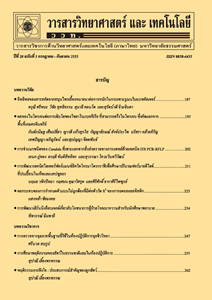ฤทธิ์ในการยับยั้ง Candida sp. ของ Cinnamaldehyde ร่วมกับ Fluconazole ในหลอดทดลอง
Main Article Content
Abstract
The aim of this study was to determine the antifungal effect of cinnamaldehyde with fluconazole against Candida sp. in vitro. The minimum inhibitory concentrations (MIC) and minimum fungicidal concentrations (MFC) of cinnamaldehyde and fluconazole against C. tropicalis U624/10, C. glabata U71/11, C. parapsilosis ATCC 22019 and C. albicans U821/10 were determined. The effect of cinnamaldehyde in combination with fluconazole against Candida sp. was evaluated by chequerboard microtiter technique. The MIC of fluconazole against C. tropicalis U624/10, C. glabata U71/11, C. parapsilosis ATCC 22019 and C. albicans U821/10 were 128, 128, 1 and 0.25 µg/ml, respectively. The MIC and MFC for cinnamaldehyde against 4 stains of Candida sp. were 125 µg/ml. By using chequerboard microtiter technique, the combination of cinnamaldehyde with fluconazole against C. glabata U71/11, C. parapsilosis ATCC 22019 and C. albicans U821/10 showed indifferent. While, antagonistic activity was observed against C. tropicalis U624/10. It can be concluded that cinnamaldehyde was failed to synergize with fluconazole against Candida spices in vitro.
Keywords: cinnamaldehyde; fluconazole; Candida sp.
Article Details
References
[2] Pappas, P.G., Rex, J.H., Sobel, J.D., Filler, S.G., Dismukes, W.E., Walsh, T.J., Edwards, J.E. and Infectious Diseases Society of America, 2004, Guidelines for treatment of candidiasis, Clin. Infect. Dis. 38: 161-189.
[3] Papon, N., Courdavault, V., Clastre, M., Richard, J. and Bennett, R.J., 2013, Emerging and emerged pathogenic Candida species: Beyond the Candida albicans paradigm, PLoS Pathogens 9: 1-4
[4] Groll, A.H. and Kolve, H., 2004, Antifungal agents: In vitro susceptibility testing, pharmacodynamics, and prospects for combination therapy, Eur. J. Clin. Microbiol. Infect. Dis. 23: 256-270.
[5] Pfaller, M.A., Pappas, P.G. and Wingard, J.R., 2006, Invasive fungal pathogens: Current epidemiological trends, Clin. Infect. Dis. 43: S3-S14.
[6] Ahmad, I., Khan, M.S.A., Zahin, M., Owais, M., Shahid, M., Mehmood, Z. and Pant, A.B., 2010, Combinational Antifungal Therapy and Recent Trends in Drug Discovery, pp. 213-240, In Ahmad, I., Owais, M., Shahid, M. and Aqil, F., Combating Fungal Infections: Problems and Remedy, Springer, New York.
[7] Shreaz, S., Bhatia, R., Khan, N., Muralidhar, S., Basir, S.F., Manzoor, N. and Khan L.A., 2011, Spice oil cinnamaldehyde exhibits potent anticandidal activity against fluconazole resistant clinical isolates, Fitoterapia 82: 1012-1020.
[8] Pootong, A., Norrapong, B. and Cowawintaweewat, S., 2017, Antifungal activity of cinnamaldehyde against Candida albicans, Southeast Asian J. Trop. Med. Public Health 48: 150-158.
[9] Subcommittee on Antifungal Susceptibility Testing (AFST) of the ESCMID European Committee for Antimicrobial Susceptibility Testing (EUCAST), 2008, Definitive document EDef 7.1: Method for the determination of broth dilution MICs of antifungal agents for fermentative yeasts, Clin. Microbiol. Infect. 14: 398-405.
[10] Vitale, R.G., Afeltra, J. and Dannaoui, E., 2005, Antifungal combinations, Meth. Mol. Med. 118: 143-152.
[11] Ghannoum, M.A. and Rice, L.B., 1999, Antifungal agents: Mode of action, mechanisms of resistance, and correlation of these mechanisms with bacterial resistance, Clin. Microbiol. Rev. 12: 501-517.
[12] Marcos-Zambrano, L.J., Escribano, P., Sánchez-Carrillo, C., Bouza, E. and Guinea, J., 2016, Scope and frequency of fluconazole trailing assessed using EUCAST in invasive Candida spp. Isolates, Med. Mycol. 54: 733-739.
[13] Khan, M.S., Malik, A. and Ahmad, I., 2012, Anti-candidal activity of essential oils alone and in combination with amphotericin B or fluconazole against multi-drug resistant isolates of Candida albicans, Med. Mycol. 50: 33-42.
[14] Shreaz, S., Bhatia, R., Khan, N., Muralidhar, S., Manzoor, N. and Khan, L.A., 2013, Influences of cinnamic aldehydes on H+ extrusion activity and ultrastructure of Candida, J. Med. Microbiol. 62: 232-240.

